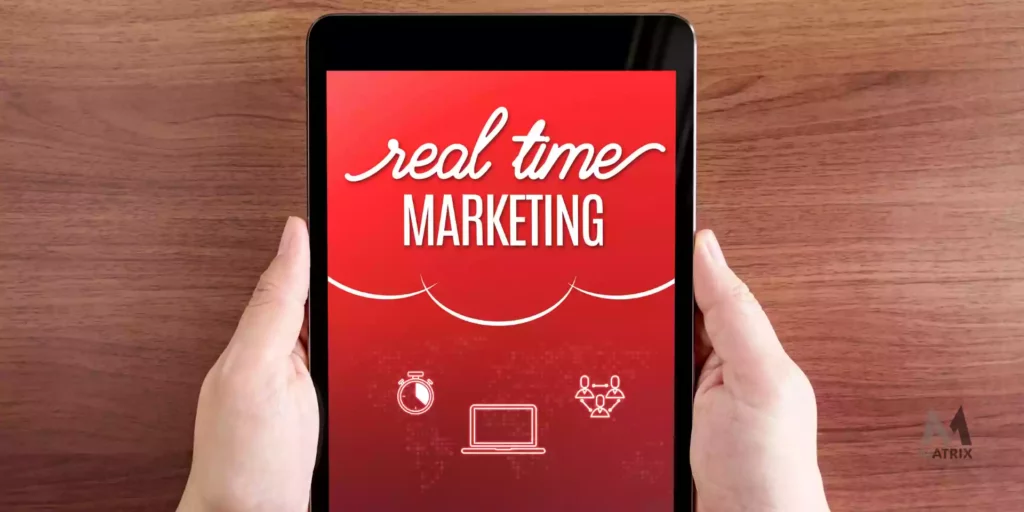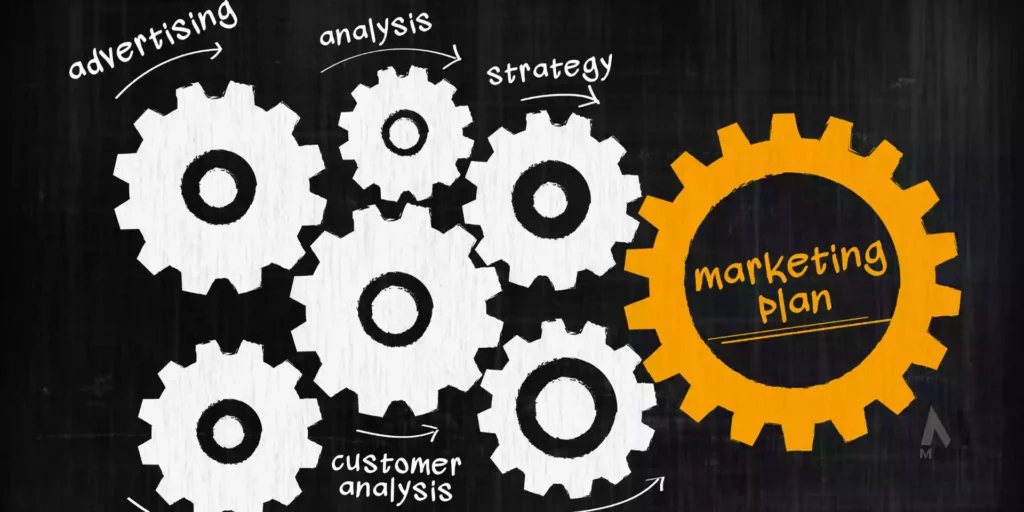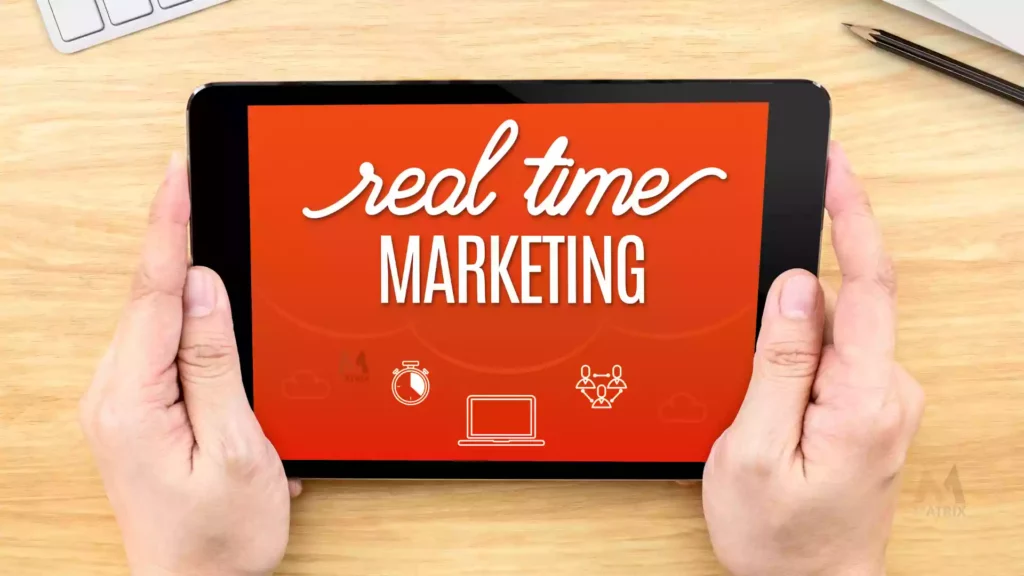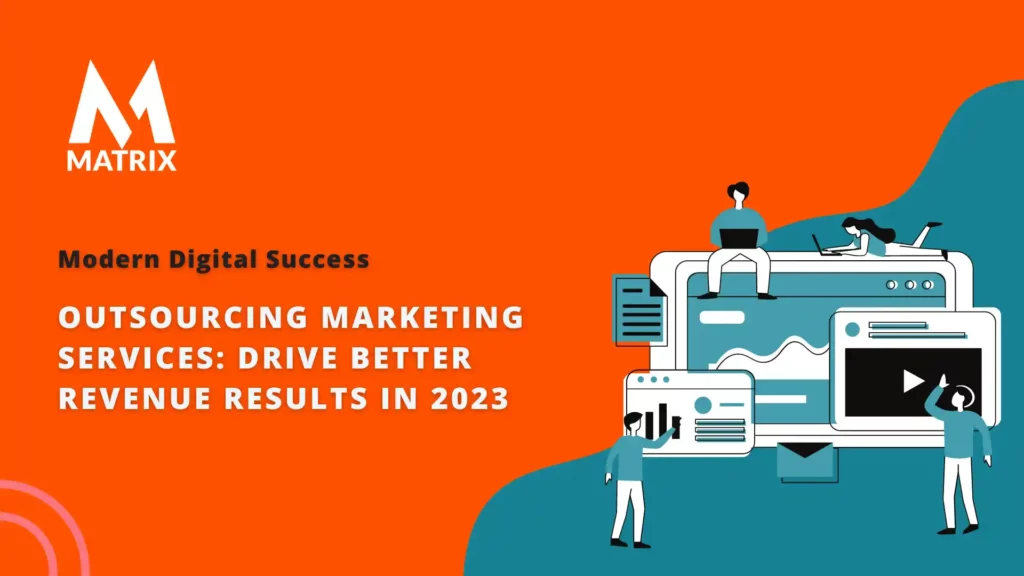Discover real-time marketing, how you can implement it successfully, and which risks you may keep in mind.
Learn about the fascinating parts of real-time marketing, how you can implement it successfully, and which risks you may keep in mind.
Modern digital marketing comes at blazing speeds; golden opportunities emerge and disappear in what seems like a flash. Competition is fiercer than ever, making grasping such prospects all the more valuable.
For these and other reasons, real-time marketing can offer an invaluable, if not almost necessary, ally. But the very term is elusive and means different things to different people – never mind applying it in action.
Thus, to help you understand and leverage it, let us discuss real-time marketing and how to implement it. As we do, we will also share examples of successful implementation for you to draw some inspiration.
What is real-time marketing?

Starting with the basics, let us first define real-time marketing. When defining a marketing strategy properly presents challenges, you can imagine what challenges the added qualifier may produce.
Notably, the term is far from new. It may acquire new meanings or find new applications over time, but the phrase and the concept are relatively old.
Younger marketers may pinpoint its first mainstream uses in the early 2010s when social media allowed for some explosive applications. But way before such opportunities, older ones may recall the term from the 90s – in a genuinely different, more straightforward form.
So what even is it? Marketers still disagree on the exact explanation, as the following definitions should help illustrate.
Definition #1
Starting with the household name that is HubSpot, their definition is as follows:
“Real-time marketing means reacting in real, or near, real-time. It’s about creating relevant messaging, and it’s achieved on social channels by listening to and anticipating customer needs. Real-time marketing focuses on current events, trends, or feedback.”
As you can see, this definition confines real-time marketing to social channels. It focuses on “messaging” on the whole and inserts the concept of “anticipating” needs alongside concentrating on current trends.
Definition #2
However, Signal has a starkly different definition:
“Real-time marketing means systematically responding to your customers at the moment based on your ability to know how a customer is interacting with your brand through any channel. […]This requires the ability to respond to customers across any channel — ranging from your social spaces to your website — in milliseconds.”
The stark contrast here comes on two different fronts. One, it expands the application of real-time marketing to “any” channel, including one’s website. Two, it altogether forgoes the component of “trends,” focusing on “respond[ing] to customers” alone.
Definition #3
Finally, G2 also has its definition in mind:
“As the name suggests, real-time marketing means reacting in real-time and creating relevant messaging through your company’s social media channels. It also requires you to actively engage in social listening to uncover customer data and identify updates regarding your brand, competitors, or industry.”
This may seem closer to HubSpot’s; it touches on competitors and one’s industry, but it primarily leans on social media. However, there’s a stark difference in context and purpose.
HubSpot pinpoints the goal as “connect[ing] with your audience and communicat[ing] your brand position,” and it primarily focuses on the aspect of social media exposure.
Instead, G2 defines the first goal as “creat[ing] content that sticks” and leans on AI-powered data that brands have used to “deepen their engagement with their audiences while building longer-lasting relationships.”
Why is real-time marketing important?

Still, despite the more significant or subtler differences in definitions, the basic principles of real-time marketing are largely uncontested:
- Timely reactions to ongoing trends, events, and industry developments
- A strong, if not exclusive, focus on social media and brand awareness
- Enriching content and outreach, with the ultimate goal of meaningful engagement and long-lasting connections
With these principles in mind, the value of real-time marketing should likely be self-evident. Among others, consider the following:
- Brand awareness is among the most coveted marketing goals, and massive exposure through smart, relevant marketing effectively raises brand awareness.
- Engagement; in the age of brand storytelling, nothing incites engagement quite as effectively as real-time marketing.
- Conversions; as audience distrust grows, real-time marketing can enhance conversion rates via trust signals and overall conversions via higher lead generation rates.
But does research support these expected outcomes? Absolutely; research finds that real-time marketing positively affects, among others:
So, in brief, real-time marketing is essential because of digital marketing demands.
Multichannel and omnichannel marketing strategies necessitate a customer-first approach and meaningful communication, and competition for both is fierce. As the research notes, customers themselves expect them more and more, and building trust requires them.
Second, it is helpful because it’s demonstrably effective and produces results.
Granted, exact results will differ, as will metrics and implementation tactics – as we’ll cover next. But the principles are demonstrably action, as research continues to show.
Real-time marketing tactics and implementation

All that said, this theoretical background should only help so much. So with it in mind, let us explore some key real-time marketing tactics to help you advance and grow your business.
#1 Start with a plan
Planning may seem antithetical to somewhat spontaneous real-time marketing. “Somewhat” is the keyword here, however, as no marketing strategy can, or should, be aimless.
Here you may begin with a plan covering all the elements you can plan for. You likely can’t predict when the next big opportunity will be or what, but you can still prepare.
First, establish your goals. It may sound almost cliché, but many marketers still begin with no objectives.
Once you do, you will also be able to pinpoint your exact KPIs. As with all forms of marketing, you will need to monitor real-time marketing as well – and for that, you will need goal-specific, relevant KPIs to gauge success through.
Next, you may decide on the channels you will use for your efforts. Depending on your definition, as outlined in the introduction, you may want to focus on specific channels over others. Social media channels that you engage in fit your business best and resonate with your audiences the most should take priority here.
Finally, you may set some strict boundaries on your team’s involvement. This does bear noting here because spontaneous outreach does invite less thought-out communication – and tonal clashes can seriously harm your branding efforts.
In brief, proactively establish the fundamentals, which subjects may be left alone, which tones are ideal, etc. Getting your teams on the same page in advance can safeguard against the risks of real-time marketing.
#2 Ensure resources

On the subject of challenges, real-time marketing admittedly comes with quite a few. Ensuring the necessary resources is among the top ones, as eConsultancy finds.
Resources you should decide on, prepare for, and dedicate to real-time marketing include:
- Staff. In most cases, you will ideally need at least one dedicated real-time marketer – if not more, depending on your scope and needs. Here you may also need to account for training and onboarding costs, resource-wise.
- Budget. No form of marketing comes without a cost, and real-time marketing is no exception. Especially if your budget is already strained, proper budgeting should be among your top early priorities.
- Analytics and data collection tools. Consider website heat maps, AI-powered predictive solutions, social listening tools, and other third-party tools and services your efforts will require. An initial cost will come early in this form; data collection drives real-time marketing at its core.
- Automation software. Similarly, automation software like CRM, social media schedulers, and email automation tools will likely be necessary. Even if you don’t use them for real-time marketing itself, automation will ease the strain on your teams and let them focus on your new endeavor.
- Competitor analysis tools. Analyzing them will let you learn from their failures and successes, informing your general marketing. With your ear on your industry’s pulse, your eye can be nowhere but on your competition.
Finally, remember that such resources may also take time to set up. Adopting new solutions, for example, requires a serious time investment into integrations, onboarding, and training for optimal results.
This bears noting because it may seem like ensuring resources is strictly about an acquisition. It is not; setting everything up and leveraging your new assets to their fullest requires time and effort.
#3 Consolidate your ambassador network
You may either proactively or gradually consolidate your ambassador network – ideally the former. This way, you can maximize the reach of your real-time marketing efforts and help increase your chances of success.
First, you may focus on the ambassadors that work best for your brand and field.
For B2C, affiliate websites aside, you may often focus primarily on social media influencers. While not traditional ambassadors, as the two do differ somewhat, influencers serve as excellent promoters of real-time marketing material.
What’s more, influencers also directly enhance trust alongside awareness. This has been consistently true since 2012 and shows no signs of changing anytime soon.
For B2B, however, you will need to delve deeper. As you primarily target decision-makers, eliciting emotional responses won’t suffice; they don’t quite resonate with the brand humanization that influencers offer.
Instead, for B2B, you may resort to traditional social ambassadors, the people who star in your success stories and have organically become your advocates. If you’ve already established a robust enough network for them before considering real-time marketing, all the better.
Similarly, for B2B, you’re highly likely already engaging in LinkedIn marketing. A staggering 93% of B2B content marketers do so already for many reasons.
You may also activate your employees for real-time marketing or tap into your existing employee advocacy programs. This too is very common and quite effective, as the above statistics also find that.
- “30% of a company’s engagement on LinkedIn comes from employees”, and
- “Employees are 14x more likely to share content from their employers than other types of content on LinkedIn.”
Of course, all other connections you can leverage will also help here.
#4 Always Be Listening (ABL)

The “core” of real-time marketing, “Always Be Listening,” is such a fundamental tenet it earned its abbreviation as ABL. This is primarily due to a simple reason; all definitions of the term agree that constant listening is imperative.
In brief, ABL constitutes the final big step toward implementing real-time marketing. This expansive step entails the following in principle:
- Before seeking to catch trends, keep an eye on your industry. Closely monitor your industry online. Monitor big topics and their oft-used keywords, and set up a Google alert for them – informing your content marketing.
- Listen in on your audiences. Employ social listening and closely monitor their needs, concerns, and subjects of interest. Your industry aside, your audiences will be the ones to make said topics big.
- Follow industry publications and leaders. For more specific, reliable data sources, remember to keep an ear on industry leaders and publications. Doing so will keep you up-to-date for everyday outreach and content while also revealing real-time marketing opportunities.
- Engage with influencers. Influencers and brand advocates are invaluable here, as the ambassador part above covered. They will expand your reach, but they will also often have insights of their own to share.
- Follow real-time events. Finally, remember never to miss an event that relates to your industry – and even ones that don’t. This kind of finger on the pulse of the digital landscape you will need to leverage repeatedly.
This is no easy feat, and real-time marketing success will always involve some luck. Still, fortune favors the bold – as even the Latin knew millennia ago.
Real-time marketing tools
Real-time marketing requires some tools to spearhead it, as we touched on previously. For clarity, here we may consolidate such tools into the following.
Social listening tools
They are the primary means of keeping track of social media discussions that don’t directly address or mention you. Social listening tools are a primary ABL asset, especially if you embrace more social media-minded real-time marketing strategies.
Tools to consider for this purpose include, among others:
- Sprout Social
- Hootsuite
- Buffer
- BuzzSumo
- Mention
- Tailwind
But don’t rush this choice just yet, as some of the following tools offer such functionalities.
Social media analytics tools
Another asset toward gauging success, social media analytics tools are crucial. Thankfully, most social media platforms now offer deep insights and tools to assist you toward this end.
Still, you may consider third-party tools for this as well, including:
- Google Analytics
- HubSpot
- TapInfluence
- Snaplytics
- Keyhole
Notably, most social listening tools will often offer such functionalities as well. Thus, you may only need one tool with some careful research for both purposes.
CRM software
Few businesses don’t use CRM today, and for a good reason. CRM databases can also offer excellent customer insights, finding many uses across marketing strategies.
Some of the best CRM solutions to consider include:
- Salesforce
- HubSpot
- Pipedrive
- Freshworks
- CompanyHub
Of course, CRM features will vary quite significantly, and so will businesses’ marketing needs. So don’t shy away from conducting thorough research if you haven’t yet picked a solution.
Appropriate automation solutions
You may also consider marketing automation tools to enhance your real-time marketing performance. Options abound here so that you may consider solutions based on your needs and budget.
For example, for email marketing, you may consider:
- ActiveCampaign
- Sendinblue
- Omnisend
- Campaign Monitor
- Constant Contact
Whereas for social media marketing, you may explore:
- SocialPilot
- ContentStudio
- ShareIt
- Buffer
- Meet Edgar
Still, many of the above and specific solutions listed offer multiple functionalities for different purposes. So first pinpoint your exact needs, and then expand to more solutions if your current assets don’t meet them.
Website analytics tools
Finally, once your real-time marketing has paid off, you still need to monitor how your website performs. An eye on your website’s analytics will always be necessary anyway, but even more so in this context.
For this purpose, you may consider:
- Google Analytics
- MonsterInsights
- Hotjar
- Kissmetrics
- Mixpanel
This choice, too, will depend on what exactly you seek to gauge, your budget, and other factors.
Examples of successful real-time marketing
Finally, before concluding, we may outline some of the most notable examples of successful real-time marketing over the years. While their success cannot be copied, they can certainly offer some inspiration.
#1 ALS Ice Bucket Challenge
Where better to start than with an example that many assert started real-time marketing as we know it?
This viral marketing phenomenon swept across the globe in 2014 as it combined the fresh concept of a “challenge” with the noble goal of raising money and awareness for ALS.
Brands small and large participated in it, as did celebrities and YouTube personalities. While replicating it will indeed be nigh impossible, this phenomenon defined the subject we’re discussing today.
#2 Oreo
Others disagree, however, citing Oreo’s famous “dunk in the dark” Super Bowl tweet from 2013 as the defining real-time marketing example.
As power in the Superdome went out, Oreo seized the opportunity and made that admittedly brilliant tweet. It garnered so much attention and was so well-received that it “left some wondering whether the quick tweet had an even greater payoff than Oreo’s actual Super Bowl ad, which cost millions more to create.”
Whichever you believe kickstarted modern real-time marketing, this one offers a different form than ALS. Namely, one that commented on ongoing events rather than championed a cause.
#3 Wendy’s
On the subject of Oreos, then, Wendy’s had some choice words for them – alongside pretty much everyone else. Leveraging its “cheeky reputation,” Wendy’s has arguably mastered the art of social media engagement like few others ever have.
Unlike specific events, Wendy’s offers another type of real-time marketing, where an established online presence constantly leverages relevant discussions. Its “sass” is so recognizable, and its “roasts” so unprecedented for any brand that every small event still shines through.
#4 Samsung
And on that note, here we may highlight another example of adversarial real-time marketing—specifically, Samsung’s infamous poke at Apple for not including chargers with their phones.
This one was successful as well; it drew attention and likely won quite a few fans over. However, this example should also highlight this kind of tactic’s risks, as Samsung quickly had to backtrack.
They soon did the same thing they used against Apple, ditching chargers themselves. This was only made worse because it had happened before; as AndroidAuthority notes, “Samsung previously posted videos mocking the iPhone’s lack of a headphone port, only to ditch the port themselves a couple of years later.”
While these missteps likely didn’t devastate Samsung’s reputation, they still backfired. And that’s precisely why a thorough plan is necessary to avoid such mishaps – especially if your image can’t afford the blow.
Conclusion
In closing, real-time marketing requires an attentive eye on your industry to reveal opportunities as they present themselves. It calls for swift responses to emerging trends to justify its name while remaining customer-focused at its core.
No matter how you seize these opportunities, keeping your finger on the pulse of your industry is essential to success. Customer and audience data is no less valuable, as it should help inform your decisions.
Thankfully, there are ample third-party solutions to assist you in this challenging task, as are examples of successful real-time marketing to draw inspiration from. While brief, hopefully, this article also served as one such source of inspiration for you.
Author
Michael Jankovic is an entrepreneurial executive currently working with ConvertMore. He has almost ten years of hands-on expertise in growing successful businesses by inspiring employees, delighting customers, and executing effective marketing strategies. His greatest strength lies in his ability to understand and manage the integration of marketing, sales, operations, customer service, and finance to create a thriving organization.
General real-time marketing FAQs
What is real-time marketing?
Definitions will vary quite significantly, but the foundation of all of them is what the name suggests. Real-time marketing entails capitalizing on valuable trends as they emerge, whether for content marketing, social media activity, or otherwise.
In all cases, “real-time” necessitates swift responses while the trend, event, or another opportunity in question still holds value.
What makes real-time marketing valuable?
There are many benefits to real-time marketing, as outlined above. Some of the most notable ones include increased brand awareness, engagement, and total conversions. Results will, of course, vary, as will KPIs one uses to gauge them.
Which tools are needed to engage in real-time marketing?
All tools that help keep your finger on your industry’s pulse are invaluable for real-time marketing. The most notable ones include Google alerts, social media listening tools, and competitor analysis tools.
How can one implement real-time marketing?
How exactly one implements, real-time marketing will ultimately depend on them. Still, B2C marketers will often leverage social media trends to raise brand awareness through engagement, while B2B marketers will commonly respond to industry trends through their content, tools, and outreach.




